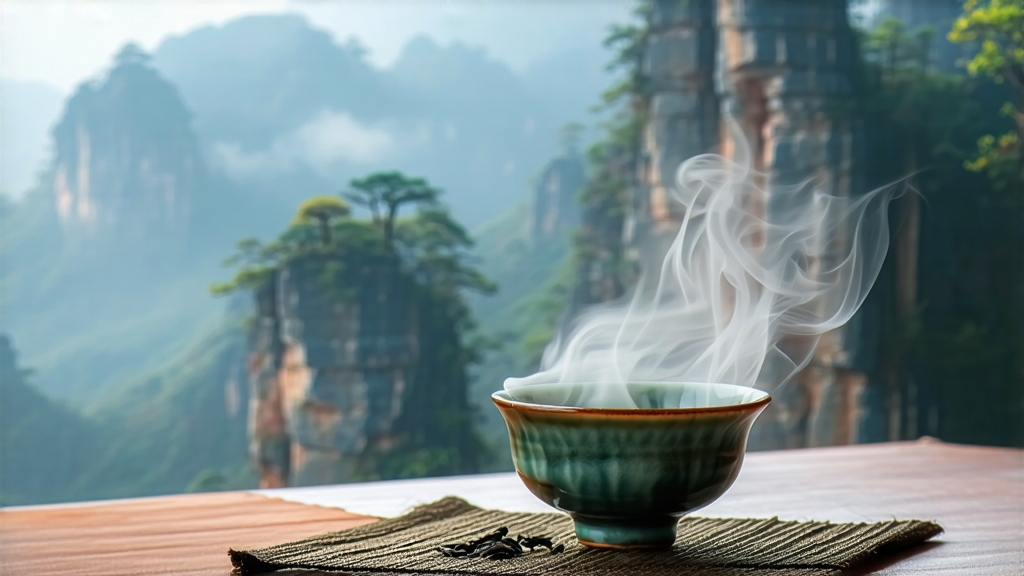
High above the winding Jiuqu Stream, where the Wuyi Mountains thrust their granite shoulders into the humid Fujian sky, tea bushes cling to narrow fissures in the cliff face. Their roots search for moisture in mineral-rich seams, anchoring themselves so tenaciously that locals joke the plants “drink stone.” From these perilous perches comes Da Hong Pao—Big Red Robe—the most mythologized of all Chinese oolongs. International drinkers often meet it first as a dark, cocoa-scented liquor in a tiny porcelain cup, yet every sip carries six centuries of imperial intrigue, Buddhist lore, and geological miracle.
The name itself is a story. During the Ming dynasty, a scholar hurrying to the capital to sit the imperial exam fell ill on the mountain path. A monk from Jiulongke monastery brewed a pot of local tea, revived the traveler, and sent him on his way. The scholar placed first, returned in crimson court robes, and draped the garment over the scraggly bushes in gratitude—hence “Big Red Robe.” Whether parable or fact, the tale is etched into Wuyi folklore and repeated by every guide who leads tourists past the gated pocket where three ancient mother trees still survive, their gnarled trunks wrapped in red cloth like the relics they are.
Botanically, Da Hong Pao is not a single cultivar but a stylistic family grown from four officially recognized clonal lines—Qidan, Beidou, Que-she, and the original “mother tree” cuttings now propagated as purebred specimens. Each strain carries a slightly different aromatic signature: Qidan leans toward orchid and burnt honey, Beidou toward mineral and ripe peach, Que-she toward white sesame and alpine sage. Yet all must obey the Wuyi definition of yan yun—“rock rhyme”—a tactile echo of stone that arrives minutes after swallowing, a cool, vibrating sensation at the back of the throat that Chinese tasters liken to the after-ring of a temple bell.
Making Da Hong Pao is a dialogue between fire and leaf that stretches across three seasons. Picking begins in late April, when only the middle three leaves have unfurled enough to balance polyphenols and sugars. Pluckers work barefoot on bamboo scaffolds lashed to the cliff, dropping leaves into wicker baskets strapped to their waists. By dusk the harvest reaches the factory courtyard, where it is spread no thicker than a finger on large rattan trays to wither under the mountain night breeze. The goal is partial dehydration; the edges must feel leathery while the central vein still snaps with moisture.
At dawn the real choreography begins. Sha-qing—“killing the green”—is done in a drum pan heated to 240 °C. The tea master tosses three kilograms of leaves at a time, rotating his wrists so the mass somersaults through the air and lands back in the center with a sound like rain on a tin roof. Two minutes later the fragrance shifts from cut grass to grilled nectarine; that is the cue to empty the leaves onto a bamboo mat and begin yao-qing, the shaking phase. Here the art is in the arm: a gentle vertical lift and drop repeated 128 times over the next hour. Cell walls fracture, enzymes meet oxygen, and the edges oxidize to a coppery red while the heart stays emerald. When the master smells ripe apricot and hot river stones, he knows oxidation has reached 30 %—the sweet spot for cliff tea.
Next comes the firing, an ordeal that would terrify most green-tea makers. The leaves are loaded into a charcoal oven built from local tuff stone and fired for eight hours at 120 °C, rested for forty days, then re-fired at 80 °C for another six. Each cycle drives out residual moisture while caramelizing sugars into notes of dark chocolate and pipe tobacco. Between firings the tea sleeps on wooden shelves inside earthen jars sealed with white paper and a slab of granite—an arrangement that allows the leaves to “dream,” as locals say, absorbing the mineral breath of the mountain. A finished batch may see two to four such cycles, and the best lots are held back by the producer for an additional year of aging so the fire mellows into a velvet ember.
To brew Da Hong Pao well, one must respect its dual nature: half delicate alpine flower, half smoldering volcano